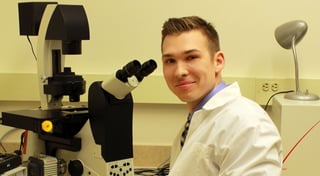 This month's research blog post comes from guest author Igor Pravdivyi, a member of Dr. Rachel Wevrick's research group at the University of Alberta.
This month's research blog post comes from guest author Igor Pravdivyi, a member of Dr. Rachel Wevrick's research group at the University of Alberta.
Children with PWS usually begin to have increased appetite around age 5, with hyperphagia setting in by age 8. This increased appetite can lead to obesity, unless the child’s eating habits are strictly regulated. The research team led by Dr. Rachel Wevrick at the University of Alberta in Canada has been looking at a hormone called leptin in a mouse model of PWS.
We proposed that pathways associated with leptin contribute to excessive appetite and obesity in PWS. Leptin is made by fat cells, and it regulates energy balance in the brain. Leptin interacts with an important class of brain cells called POMC neurons. Leptin normally tells POMC neurons to act like a brake to reduce food intake. Our previous work uncovered defective leptin pathways in adult PWS mice (Mercer, PLoS Genetics, 2013). In this new FPWR-funded study published in Human Molecular Genetics (Pravdivyi HMG 2015), we investigated the leptin pathways in our PWS model mice from birth through adulthood.
Many genes are inactivated in individuals with PWS. Recently, children with a syndrome that is similar to PWS were found to have mutations in just one of these inactivated PWS genes, a gene called MAGEL2. Our PWS mice are missing only the MAGEL2 gene. In this study, we measured the effect of leptin on POMC neurons in mice missing MAGEL2. We were surprised to find that in very young mouse pups missing MAGEL2, their POMC neurons responded to leptin normally. By the time the MAGEL2 mice entered adolescence, fewer of their POMC neurons were activated by leptin. Finally, POMC neurons in adult MAGEL2 mice did not respond to leptin at all.
POMC neurons have connections to various parts of the brain that participate in the control of appetite and eating behavior. Strikingly, we found that the MAGEL2 mice have fewer connections from their POMC neurons to the rest of the brain. Their POMC neurons are less able to activate the brake that reduces food intake because they have fewer of these connections.
Our finding that these neural defects are not apparent until adolescence may help explain why toddlers with PWS have a period of normal appetite, but then face a gradual increase in appetite that progresses to continual hunger and lack of satiety by the time they enter their teens. We speculate that, in principle, protecting the health of critical POMC neurons in early childhood could prevent the onset of increased appetite in children with PWS.







